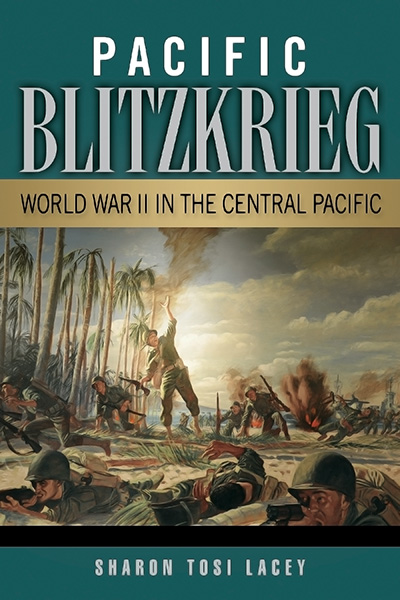
- History/Military Book Club Selection, 2013
- Distinguished Writing Award in Operational/Battle History, from the Army Historical Foundation, 2014
- Selected by General Raymond Odierno, 38th Army Chief of Staff, for the U.S. Army Chief of Staff's Professional Reading List, February 2014
- Crader Family Book Prize in American Values
July, 2015
Published
336
Pages
35 b&w photos. 5 maps. Notes. Bib. Index.
Features
Best Seller
Ideal for Classrooms
Sample Reading
About Lacey's Pacific Blitzkrieg
Pacific Blitzkrieg closely examines the planning, preparation, and execution of ground operations for five major invasions in the Central Pacific (Guadalcanal, Tarawa, the Marshalls, Saipan, and Okinawa). The commanders on the ground had to integrate the U.S. Army and Marine Corps into a single striking force, something that would have been difficult in peacetime, but in the midst of a great global war, it was a monumental task. Yet, ultimate success in the Pacific rested on this crucial, if somewhat strained, partnership and its accomplishments. Despite the thousands of works covering almost every aspect of World War II in the Pacific, until now no one has examined the detailed mechanics behind this transformation at the corps and division level.
Sharon Tosi Lacey makes extensive use of previously untapped primary research material to re-examine the development of joint ground operations, the rapid transformation of tactics and equipment, and the evolution of command relationships between army and marine leadership. This joint venture was the result of difficult and patient work by commanders and evolving staffs who acted upon the lessons of each engagement with remarkable speed. For every brilliant strategic and operational decision of the war, there were thousands of minute actions and adaptations that made such brilliance possible.
Lacey examines the Smith vs. Smith controversy during the Saipan invasion using newly discovered primary source material. Saipan was not the first time General “Howlin’ Mad” Smith had created friction. Lacey reveals how Smith’s blatant partisanship and inability to get along with others nearly brought the American march across the Pacific to a halt.
Pacific Blitzkrieg explores the combat in each invasion to show how the battles were planned, how raw recruits were turned into efficient combat forces, how battle doctrine was created on the fly, and how every service remade itself as new and more deadly weapons continuously changed the character of the war. This book will be a must read for anyone who wants to get behind-the-scenes story of the victory.
“Pacific Blitzkrieg is not only a major contribution to our understanding of the Pacific War, but is also a delight to read. Lacey demolishes the belief, widely held among students of the Pacific War, that a deep gulf lay between the Marine Corps and the Army. In every respect Pacific Blitzkrieg is what one should expect from a scholarly book: well researched, well argued, and coherent.” —Williamson Murray, coauthor of A War to Be Won: Fighting the Second World War
“This is a significantly fresh approach in that it goes beyond the Army-Marine controversies best exemplified by ‘Smith versus Smith.’ It does so by explaining their genesis in institutional and personal terms, then showing how both services marginalized the controversies during the war, in the interest of resolving the [real] {: .underline} problem: crossing the central Pacific with minimum cost and maximum effectiveness.” —Dennis E. Showalter, author of Hitler’s Panzers and Patton and Rommel
“A must read for current and future joint force commanders and their staffs.” —Peter R. Mansoor, author of The GI Offensive in Europe
“This book is an important contribution to our understanding of the Pacific War, especially as it relates to the evolving joint doctrine and, in particular, the storied—and, at times, turbulent—relationship between the Army and the Marine Corps. It will be of great interest to most readers of ARMY magazine, but it is definitely a must-read for anyone with interest in World War II’s Pacific Theater.” —ARMY
Classroom Adoption
Pacific Blitzkrieg: World War II in the Central Pacific is a recommended text for use in classrooms where the following subjects are being studied: History, Military.
Pacific Blitzkrieg closely examines the planning, preparation, and execution of ground operations for five major invasions in the Central Pacific (Guadalcanal, Tarawa, the Marshalls, Saipan, and Okinawa). The commanders on the ground had to integrate the U.S. Army and Marine Corps into a single striking force, something that would have been difficult in peacetime, but in the midst of a great global war, it was a monumental task. Yet, ultimate success in the Pacific rested on this crucial, if somewhat strained, partnership and its accomplishments. Pacific Blitzkrieg explores the combat in each invasion to show how the battles were planned, how raw recruits were turned into efficient combat forces, how battle doctrine was created on the fly, and how every service remade itself as new and more deadly weapons continuously changed the character of the war.
Adopted By
[“Hamilton College for "U.S. Foreign Policy"”]
About the Author
SHARON TOSI LACEY earned her Ph.D. in military history from the University of Leeds, and is also a graduate of the United States Military Academy and Long Island University. She has served as a U.S. Army officer for more than 22 years and published more than 30 articles on military issues in magazines and journals. She currently lives in Northern Virginia with her husband and four children.
Buy Now
Pacific Blitzkrieg: World War II in the Central Pacific
336 pp. 35 b&w photos. 5 maps. Notes. Bib. Index.